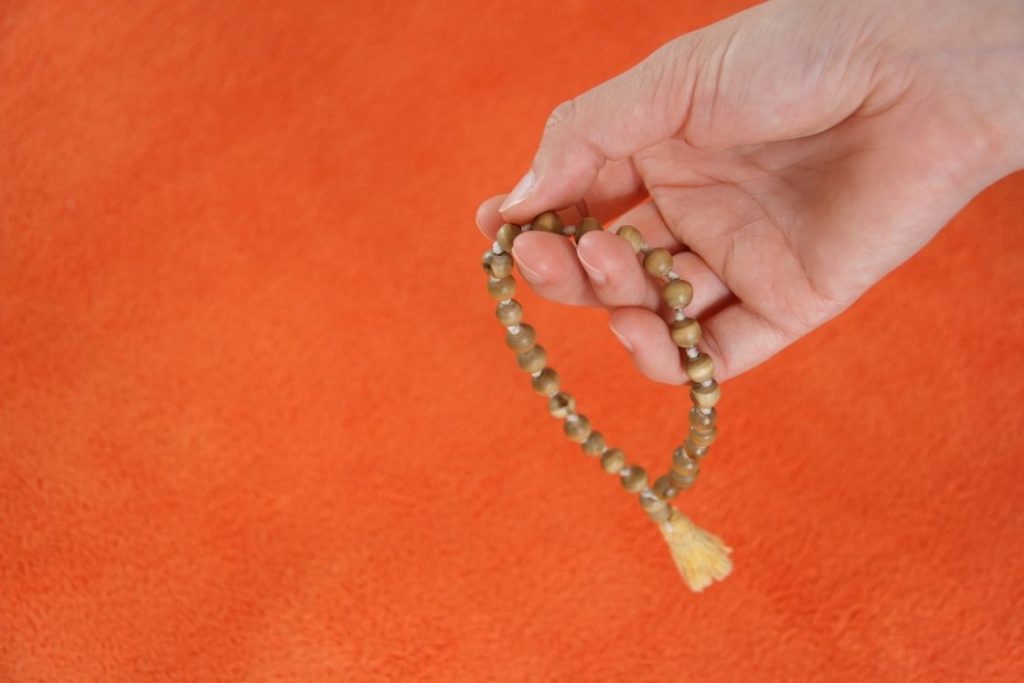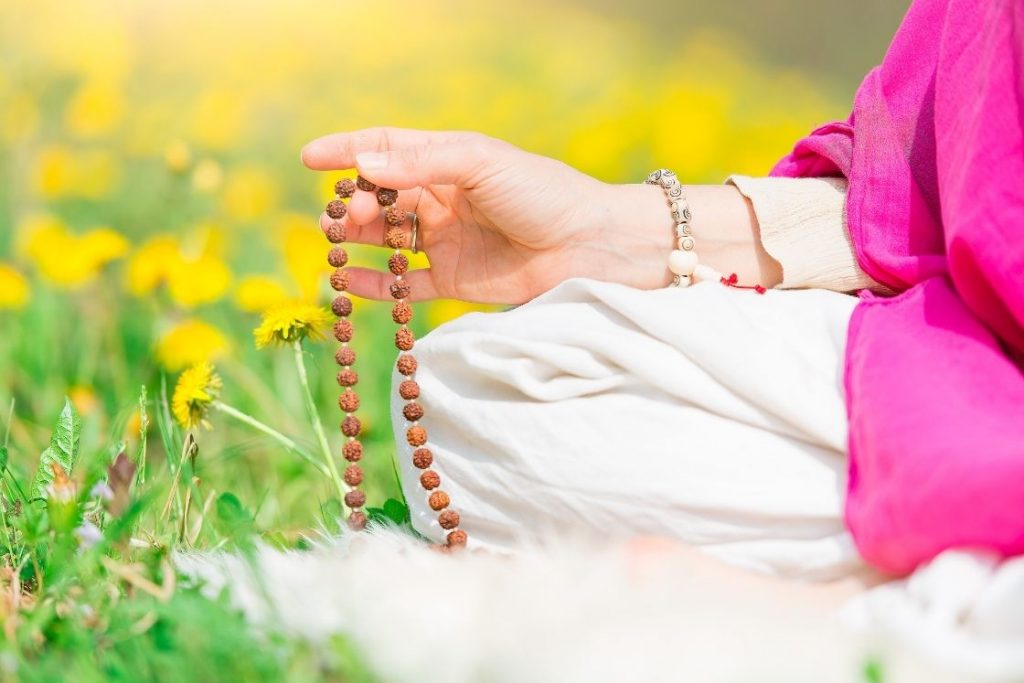
Mantra chanting has been done since ancient times. Not just for rituals but also to achieve inner peace, tranquillity, and connection with the divine. These mantras can be as simple as OM, a phrase such as “OM Shanti, Shanti, Shanti”, a bija mantra such as hreem, shreem, or an entire verse such as the Gayatri Mantra.
In mantra yoga, mantras can be chanted out loudly, softly, silently in the mind, or even while writing. This chanting of mantra is what is essentially known as Japa. If you are chanting a mantra during meditation, it will be called a Japa meditation.
A Japa meditation is mostly done with the help of a Japa mala or garland. The mala is a string that contains beads made from gemstones or crystals that contain special energies. While performing Japa, you count on each bead, which helps you focus on your meditation and chanting.
In this article, we will discuss the meaning of Japa, the significance of using Japa mala, the benefits of performing Japa, and how you can effectively perform Japa meditation.
What is japa?

Japa is a Sanskrit word that is derived from the root word jap which means “to utter in a low voice, repeat internally, mutter”.
It can also be broken down into ja meaning to destroy the cycle of birth, death and reincarnation and pa meaning to destroy sins of oneself.
In yoga, Japa is considered the practice of repeatedly chanting a beej mantra or specific affirmation to concentrate the mind. The uninterrupted concentration for a longer duration leads to meditation.
A Japa practice is usually done with Japa mala in which the practitioner counts the beads as chanting the mantra. Each bead counting corresponds to one chant of mantra. Normally a Japa mala comes with 108 beads.
Performing Japa will help in removing impure or negative thoughts from the mind, remove or destroy your sins which will ultimately lead to samadhi – the last stage of yoga. During meditation, performing Japa with a mala will help you achieve a higher state of awareness.
It also creates a positive pattern of thoughts that can help you overcome negativity or darkness.
Types of Japa
The inherent definition of Japa tells us that it should be uttered in a low voice, however, you can perform a Japa in varying degrees of loudness.
Vaikhari Japa – When the mantra is chanted out loud so that even others can also hear, it is vaikhari Japa. This type of Japa can come in handy when there are sounds nearby and you are unable to concentrate.
Upamshu Japa – Mantra chanted softly or in a whisper tone is called upamshu Japa. In this type of Japa practice, the lips of the practitioner barely move. Upamshu japa is considered more effective than vaikhari japa.
Manasik Japa – Manasik Japa is when you repeatedly chant the mantra in your mind. It is difficult to chant something in the mind as you need immense focus and concentration and a determination to not get distracted. Also, this type of japa is considered the most powerful when compared to the above two.
There is also another type of Japa where you write the mantra as you speak it out loud or keep silent. This is called likhita Japa. It is a form of Japa meditation where instead of counting on Japa mala beads, you are writing down the mantra for enhanced concentration.
Rules for practicing japa
Japa meditation requires you to follow certain do’s and don’ts to avoid unintentionally disrespecting the mantra or the tradition. If not done correctly, it may also lead to adverse effects.
- Choose a quiet and clean space where you won’t be disturbed. Keep all electronic devices away to avoid distractions.
- Never sit directly on the floor. Use a cloth or yoga mat to prevent energy loss.
- The ideal time for Japa is during Brahma Muhurta (pre-dawn hours). Bathe or at least wash your face, hands, and feet before beginning. You may also practise at dusk if mornings aren’t possible.
- Sit down in a pose that you can sustain for a duration of 1-2 hours. Sukhasana (Easy Pose) is one of the most preferred poses for Japa meditation.
- Choose a mantra that resonates with you. Avoid complex or lengthy mantras unless guided by a teacher.
- If you have received a personal mantra from a guru, you may use it but do not share it with others.
- Hold the Japa mala in your right hand, looping it over the middle finger. The index finger should not touch the beads. Use your thumb to roll each bead during chanting.
- Ensure the mala does not fall below the navel or touch the ground. Support your hand at heart level or below the nose.
- Chant each mantra clearly and with correct pronunciation. Avoid rushing or chanting too slowly.
- Start with the guru or meru bead, the largest bead in the mala which often has a tassel attached to it. Pull each bead towards you as you chant the mantra. The guru bead shouldn’t be used in counting.
- Once you have reached the guru bead, do not pass over it. Flip the bead and count in the reverse direction.
- Practice the japa 108 times. The japa mala is commonly made with 108 beads for this purpose.
- If you are practicing manasik japa and feel distracted, start with upamshu japa. If you still cannot concentrate, you can practice vaikhari japa. Return to mansik japa as soon as possible.
- After completing Japa, remain seated in silence for a few minutes. You may recite a closing prayer or simply take deep, calming breaths.
Other important factors of practising Japa are:
- Keep your Japa mala clean. Wash it daily after completing your practice to maintain purity.
- Store it in a safe place. Preferably use a mala bag to store them neatly.
- Store your mala in a safe and clean place. Ideally, keep it in a dedicated mala bag to protect it from dust and damage.
- Cover your mala while practising. It is often recommended to use a clean handkerchief or towel to cover the mala during Japa as a sign of respect.
- Keep a firm resolve to complete the japa in one sitting.
- Instead of a mala, you can also practice jap with the help of a watch or count on your fingers.
- If possible, face east or north as it enhances the power of japa.
- Stick to one mantra for a period of time to make it work.
Benefits of practicing japa

Japa, the repetitive chanting of a sacred mantra, brings peace to the mind and creates a deep spiritual connection. This practice helps release stress, clears mental clutter, and invites positive energy into your life. Over time, Japa can become a powerful tool for inner transformation.
Some of the benefits of mantra Japa are:
- Japa practice calm your mind and improve focus.
- With Japa practice your sleep pattern and quality gets improved.
- As you need to sit in one position for a longer duration, Japa increases your level of patience and resilience.
- If you do not want to practice meditation on some days, you can instead practice japa as it can be practiced anywhere.
- Japa practice creates a sense of discipline as it requires you to do the chanting of mantras regularly in the same place.
- By repeating a mantra over time, you are tapping into the healing and protective powers of the ancient mantras.
- You can change the pace of reciting the mantra as per your concentration levels and state of mind.
- Practicing japa will cleanse your thoughts and negative energies to make way for positivity.
- You can improve your meditation if you perform japa before starting your meditative practice.
- Even during your meditation, if you have developed good control of your mind, you can practice manasik japa easily.
- It helps in purifying your soul as you perform japa without any expectations of return.
How to use japa mala
Mala is one of the integral parts of Japa meditation practice. And while doing Japa, using a mala has become essential for keeping a count.
So before you get to know the usage of Japa mala, let us see what the mala is made up of.
The beads of the mala are made from multiple materials such as sandalwood, seeds of tulsi (holy basil), gemstones, crystals, semi-precious or precious stones, etc. You can choose a mala based on your preference or a stone that has been recommended by a guru.

Hold the mala on your right hand. Loop the mala over the middle (or, and ring) finger in such a way that the guru bead is pointing up and all other beads are hanging down. Use the thumb to grasp the first bead and slide it to one side of the guru bead. Chant the mantra as your grasp and slide the first bead. Keep holding it until one chant gets finished. Then chant on the next bead in this process.
Make sure your index finger not touching mala in this process as it’s considered it contains negative energies. Keep index finger separated (above) from other fingers.
Pronounce your Mantra or affirmation distinctly and clearly. While performing Japa meditation, the eyes should be closed completely. You should complete a round of 108 times counting the beads.
Mostly, a Japa mala consists of 108 beads. 108 carries a spiritual significance in Hinduism and Buddhism due to many reasons:
- It is considered that there are 108 earthly desires in human beings.
- Some say that humans posses 108 feelings – 36 past, 36 present and 36 future-related feelings.
- 108 is also the number that comes when we multiply the 12 constellations or houses with 9 arc segments or planets.
- The Sanskrit alphabet has 54 letters and each letter has a masculine (Shiva) and feminine (Shakti) energy. Thus, 54×2=108.
- There is also a notion that 1 represents God or one supreme power, 0 stands for emptiness or completeness in spirituality, and 8 is for infinity or eternity.
The 109th bead is the guru bead or the Meru bead. It is the starting point of counting for the mantra Japa. Spiritually it pays homage to the relationship of student and guru as the mala is often given by the guru.
Activating japa mala
Before starting the mantra Japa with your mala, it should be activated. Because without it, the energy trapped within the beads will lie dormant and not help you out in any way. It will also help your mala being unique to you, which is why you shouldn’t give it to anyone.
If you have received your Japa mala from your guru, it will already have been activated by them and you can start your mantra Japa right away.
However, if you have bought the mala yourself and want to activate it at home, follow this process:
- Come into a position that is most comfortable for you. You can either sit in a meditative posture, stand or even lie down.
- Hold the mala in your right hand. The mala should be placed between the middle and index finger with the index finger pointed outwards.
- Start from the guru bead and roll each bead towards you.
- Recite a mantra that resonates with you the most. Gayatri mantra is commonly chanted mantra you can pick.
- After you have finished one full circle of the mala, hold it in your palms and bring the palm towards your third eye chakra and the heart chakra.
- Sit silently for a few minutes and take deep breaths.
Can we wear japa mala?
In many spiritual traditions, it’s common to see people wearing a japa mala around their neck or wrist but is it appropriate?
Yes, you can wear a japa mala, as long as it’s done with respect and intention. It should touch your bare skin, not be worn over clothing, and should never be treated like an accessory or fashion item.
However, there are a few important guidelines to follow:
- Remove the mala before sleeping, using the restroom, or entering public places where it may be disrespected.
- Wear it mindfully, as a sacred object—not as jewellery.
- Store it carefully in a mala bag or place it on a clean altar with your spiritual books or items when not in use.
- Don’t share your mala. Each mala absorbs the energy and intention of its user. Sharing it can interfere with its personal spiritual vibration.
Wearing a mala with reverence can help you stay connected to your practice throughout the day, as long as it’s worn with sincerity, not show.
How to do japa meditation
Japa meditation is a sacred practice of chanting a mantra repeatedly to focus the mind and purify the heart. Using a mala (prayer beads), the repetition of a mantra helps settle your thoughts and deepen your spiritual awareness.
Here’s a step-by-step guide to practising Japa meditation effectively:
- Find a peaceful place in your home where you won’t be disturbed. Ideally, the space should feel calm and energetically pure.
- Sit in a meditative posture such as Sukhasana (Easy Pose) or Padmasana (Lotus Pose)—or any position you can maintain comfortably for 20 to 60 minutes.
- Use your right hand to hold the mala. Let the mala rest between your middle finger and thumb, avoiding contact with the index finger, which symbolises the ego in yogic tradition.
- Close your eyes and start silently repeating your chosen mantra. After each repetition, move to the next bead by gently pulling it toward you with your thumb.
- When you reach the guru bead (the larger bead), pause. Instead of crossing over it, turn the mala around and continue your chanting in the opposite direction.
- Keep the mala at chest level or above the navel. Avoid letting it touch the ground. You can place your left hand underneath for support.
- After completing your round(s), sit quietly for a few minutes. Take deep breaths or offer a short prayer of gratitude. This helps your mind absorb the benefits of the practice and carry them into your day.
Conclusion
Japa meditation is a powerful way to deepen your spiritual practice by adding the repetition of a beej mantra to your meditation. With regular practice, it helps quiet the mind, release stress, and bring positive energy into your life.
Start small just 10 to 15 minutes a day. If silent chanting feels difficult at first, begin by whispering or speaking the mantra aloud. Over time, as your focus grows, you’ll find it easier to shift into silent (manasik) japa.
With patience and consistency, Japa meditation can bring clarity, emotional balance, and a deeper connection to your inner self.




